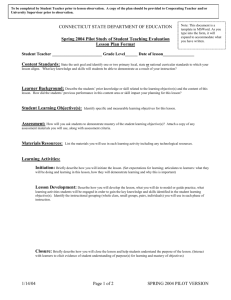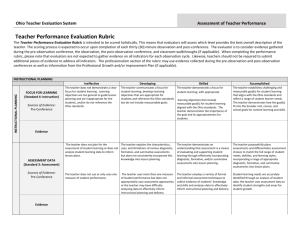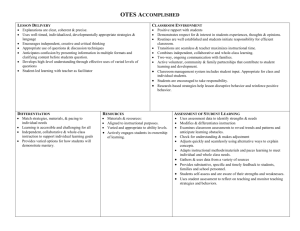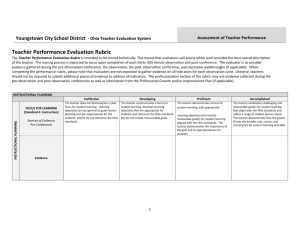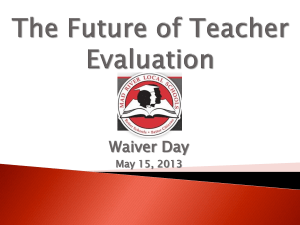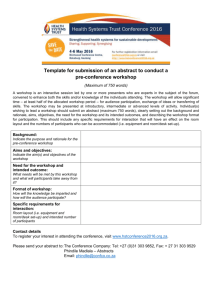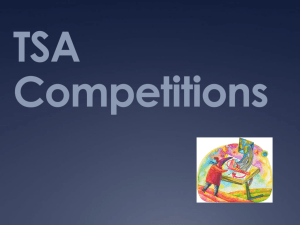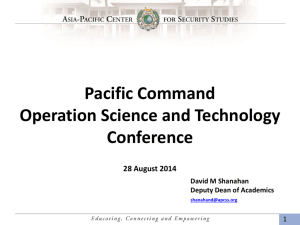OTES and 5-Step Process
advertisement
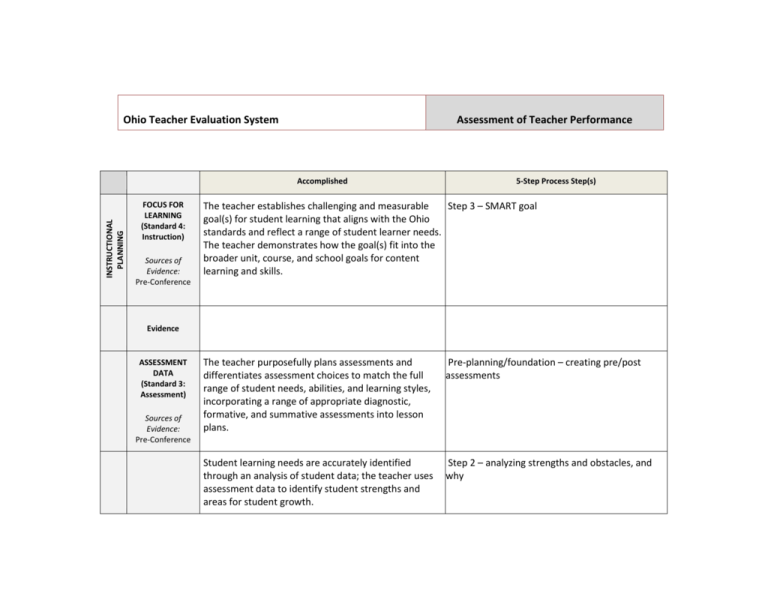
Ohio Teacher Evaluation System Assessment of Teacher Performance INSTRUCTIONAL PLANNING Accomplished FOCUS FOR LEARNING (Standard 4: Instruction) Sources of Evidence: Pre-Conference 5-Step Process Step(s) The teacher establishes challenging and measurable Step 3 – SMART goal goal(s) for student learning that aligns with the Ohio standards and reflect a range of student learner needs. The teacher demonstrates how the goal(s) fit into the broader unit, course, and school goals for content learning and skills. Evidence ASSESSMENT DATA (Standard 3: Assessment) Sources of Evidence: Pre-Conference The teacher purposefully plans assessments and differentiates assessment choices to match the full range of student needs, abilities, and learning styles, incorporating a range of appropriate diagnostic, formative, and summative assessments into lesson plans. Pre-planning/foundation – creating pre/post assessments Student learning needs are accurately identified through an analysis of student data; the teacher uses assessment data to identify student strengths and areas for student growth. Step 2 – analyzing strengths and obstacles, and why Evidence INSTRUCTIONAL PLANNING Accomplished PRIOR CONTENT KNOWLEDGE / SEQUENCE / CONNECTIONS (Standard 1: Students; Standard 2: Content; Standard 4: Instruction) Sources of Evidence: Pre-Conference The teacher uses the input and contributions of families, colleagues, and other professionals in understanding each learner’s prior knowledge and supporting their development. The teacher makes meaningful and relevant connections between lesson content and other disciplines and real-world experiences and careers as well as prepares opportunities for students to apply learning from different content areas to solve problems. The teacher plans and sequences instruction that reflects an understanding of the prerequisite relationships among the important content, concepts, and processes in school and district curriculum priorities and in state standards as well as multiple pathways for learning depending on student needs. The teacher accurately explains how the lesson fits within the structure of the discipline. Evidence INSTRUCTIONAL PLANNING KNOWLEDGE OF STUDENTS (Standard 1: Students) Sources of Evidence: Analysis of Student Data Pre-Conference The teacher demonstrates an understanding of the purpose and value of learning about students’ background experiences, demonstrates familiarity with each student’s background knowledge and experiences, and describes multiple procedures used to obtain this information. The teacher’s analysis of student data (student development, student learning and preferred learning styles, and student backgrounds/prior experiences) accurately connects the data to specific instructional strategies and plans. The teacher plans for and can articulate specific strategies, content, and delivery that will meet the needs of individual students and groups of students. Evidence INSTRUCTION AND ASSESSMENT Accomplished LESSON DELIVERY (Standard 2: Content; Standard 4: Instruction; Standard 6: Collaboration and Communication) Teacher explanations are clear, coherent, and precise. The teacher uses well-timed, individualized, developmentally appropriate strategies and language designed to actively encourage independent, creative, and critical thinking, including the appropriate use of questions and discussion techniques. Sources of Evidence: Formal Observation Classroom Walkthroughs/ Informal Observations The teacher accurately anticipates confusion by presenting information in multiple formats and clarifying content before students ask questions. The teacher develops high-level understanding through effective uses of varied levels of questions. The lesson is student-led, with the teacher in the role of facilitator. Evidence DIFFERENTIATION (Standard 1: Students; Standard 4: Instruction) Sources of Evidence: Pre-Conference Formal Observation Classroom Walkthroughs/ Informal Observations The teacher matches strategies, materials, and/or pacing to students’ individual needs, to make learning accessible and challenging for all students in the classroom . The teacher effectively uses independent, collaborative and whole-class instruction to support individual learning goals and provides varied options for how students will demonstrate mastery. Evidence RESOURCES (Standard 2: Content; Standard 4: Instruction) Sources of Evidence: Pre-Conference Formal Observation Classroom Walkthroughs/ Informal Observations Evidence Instructional materials and resources are aligned to instructional purposes, are varied and appropriate to ability levels of students, and actively engage them in ownership of their learning. INSTRUCTION AND ASSESSMENT Accomplished CLASSROOM ENVIRONMENT (Standard 1: Students; Standard 5: Learning Environment; Standard 6: Collaboration and Communication) The teacher has positive rapport with students and demonstrates respect for and interest in individual students’ experiences, thoughts and opinions. For example, the teacher responds quietly, individually, and sensitively to student confusion or distress. Sources of Evidence: Pre-Conference Formal Observation Classroom Walkthroughs/ Informal Observations Routines are well-established and orderly and students initiate responsibility for the efficient operation of the classroom. Transitions are seamless as the teacher effectively maximizes instructional time and combines independent, collaborative, and whole-class learning situations. The teacher engages in two-way, ongoing communication with families that results in active volunteer, community, and family partnerships which contribute to student learning and development. A classroom management system has been designed, implemented, and adjusted with student input and is appropriate for the classroom and individual student needs. Students are actively encouraged to take responsibility for their behavior. The teacher uses research-based strategies to lessen disruptive behaviors and reinforce positive behaviors. Evidence INSTRUCTION AND ASSESSMENT Accomplished ASSESSMENT OF STUDENT LEARNING (Standard 3: Assessment) Sources of Evidence: Pre-Conference Formal Observation Classroom Walkthroughs/ Informal Observations Post-Conference The teacher uses assessment data to identify students’ strengths and needs, and modifies and differentiates instruction accordingly, as well as examines classroom assessment results to reveal trends and patterns in individual and group progress and to anticipate learning obstacles. The teacher continually checks for understanding and makes adjustments accordingly (whole-class or individual students). When an explanation is not effectively leading students to understand the content, the teacher adjusts quickly and seamlessly within the lesson and uses an alternative way to explain the concept. By using student data from a variety of sources, the teacher appropriately adapts instructional methods and materials and paces learning activities to meet the needs of individual students as well as the whole class. The teacher provides substantive, specific, and timely feedback to students, families, and other school personnel while maintaining confidentiality. The teacher provides the opportunity for students to engage in selfassessment and show awareness of their own strengths and weaknesses. The teacher uses student assessment results to reflect on his or her own teaching and to monitor teaching strategies and behaviors in relation to student success. Evidence Accomplished PROFESSIONALISM PROFESSIONAL RESPONSIBILITIES (Standard 6: Collaboration and Communication; Standard 7: Professional Responsibility and Growth) The teacher communicates effectively with students, families, and colleagues. The teacher collaborates with colleagues to improve personal and team practices by facilitating professional dialogue, peer observation and feedback, peer coaching and other collegial learning activities. Sources of Evidence: Professional Development Plan or Improvement Plan; Preconference; Post-conference; daily interaction with others The teacher meets ethical and professional responsibilities and helps colleagues access and interpret laws and policies and understand their implications in the classroom. The teacher sets and regularly modifies short-and longterm professional goals based on self-assessment and analysis of student learning evidence. Evidence
